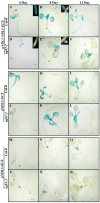Arabidopsis NDL-AGB1 modules Play Role in Abiotic Stress and Hormonal Responses Along with Their Specific Functions
- PMID: 31554237
- PMCID: PMC6801982
- DOI: 10.3390/ijms20194736
Arabidopsis NDL-AGB1 modules Play Role in Abiotic Stress and Hormonal Responses Along with Their Specific Functions
Abstract
Arabidopsis N-MYC Downregulated Like Proteins (NDLs) are interacting partners of G-Protein core components. Animal homologs of the gene family N-myc downstream regulated gene (NDRG) has been found to be induced during hypoxia, DNA damage, in presence of reducing agent, increased intracellular calcium level and in response to metal ions like nickel and cobalt, which indicates the involvement of the gene family during stress responses. Arabidopsis NDL gene family contains three homologs NDL1, NDL2 and NDL3 which share up to 75% identity at protein level. Previous studies on NDL proteins involved detailed characterization of the role of NDL1; roles of other two members were also established in root and shoot development using miRNA knockdown approach. Role of entire family in development has been established but specific functions of NDL2 and NDL3 if any are still unknown. Our in-silico analysis of NDLs promoters reveled that all three members share some common and some specific transcription factors (TFs) binding sites, hinting towards their common as well as specific functions. Based on promoter elements characteristics, present study was designed to carry out comparative analysis of the Arabidopsis NDL family during different stages of plant development, under various abiotic stresses and plant hormonal responses, in order to find out their specific and combined roles in plant growth and development. Developmental analysis using GUS fusion revealed specific localization/expression during different stages of development for all three family members. Stress analysis after treatment with various hormonal and abiotic stresses showed stress and tissue-specific differential expression patterns for all three NDL members. All three NDL members were collectively showed role in dehydration stress along with specific responses to various treatments. Their specific expression patterns were affected by presence of interacting partner the Arabidopsis heterotrimeric G-protein β subunit 1 (AGB1). The present study will improve our understanding of the possible molecular mechanisms of action of the independent NDL-AGB1 modules during stress and hormonal responses. These findings also suggest potential use of this knowledge for crop improvement.
Keywords: Arabidopsis; GUS staining; N-Myc downregulated like; PEG; abiotic stress; mannitol; plant hormones; promoter elements.
Conflict of interest statement
The authors declare no conflict of interest.
Figures










Similar articles
-
Molecular Characterization of NDL1-AGB1 Mediated Salt Stress Signaling: Further Exploration of the Role of NDL1 Interacting Partners.Cells. 2021 Aug 31;10(9):2261. doi: 10.3390/cells10092261. Cells. 2021. PMID: 34571915 Free PMC article.
-
Arabidopsis N-MYC DOWNREGULATED-LIKE1, a positive regulator of auxin transport in a G protein-mediated pathway.Plant Cell. 2009 Nov;21(11):3591-609. doi: 10.1105/tpc.109.065557. Epub 2009 Nov 30. Plant Cell. 2009. PMID: 19948787 Free PMC article.
-
N-MYC down-regulated-like proteins regulate meristem initiation by modulating auxin transport and MAX2 expression.PLoS One. 2013 Nov 4;8(11):e77863. doi: 10.1371/journal.pone.0077863. eCollection 2013. PLoS One. 2013. PMID: 24223735 Free PMC article.
-
Transcriptome meta-analysis-based identification of hub transcription factors and RNA-binding proteins potentially orchestrating gene regulatory cascades and crosstalk in response to abiotic stresses in Arabidopsis thaliana.J Appl Genet. 2024 May;65(2):255-269. doi: 10.1007/s13353-024-00837-4. Epub 2024 Feb 10. J Appl Genet. 2024. PMID: 38337133 Review.
-
A Revised View of the LSU Gene Family: New Functions in Plant Stress Responses and Phytohormone Signaling.Int J Mol Sci. 2023 Feb 1;24(3):2819. doi: 10.3390/ijms24032819. Int J Mol Sci. 2023. PMID: 36769138 Free PMC article. Review.
Cited by
-
Chromosomal Distribution of Genes Conferring Tolerance to Abiotic Stresses Versus That of Genes Controlling Resistance to Biotic Stresses in Plants.Int J Mol Sci. 2020 Mar 6;21(5):1820. doi: 10.3390/ijms21051820. Int J Mol Sci. 2020. PMID: 32155784 Free PMC article.
-
Molecular Characterization of NDL1-AGB1 Mediated Salt Stress Signaling: Further Exploration of the Role of NDL1 Interacting Partners.Cells. 2021 Aug 31;10(9):2261. doi: 10.3390/cells10092261. Cells. 2021. PMID: 34571915 Free PMC article.
References
-
- Ming C.H., Xu D.B., Fang G.N., Wang E.H., Gao S.Q., Xu Z.S., Li L.C., Zhang X.H., Miin D.H. G-protein β subunit AGB1 positively regulates salt stress tolerance in Arabidopsis. J. Integr. Agric. 2015;14:314–325.
-
- Klopffleisch K., Phan N., Augustin K., Bayne R.S., Booker K.S., Botella J.R., Carpita N.C., Carr T., Chen J.G., Cooke T.R., et al. Arabidopsis G-protein interactome reveals connections to cell wall carbohydrates and morphogenesis. Mol. Syst. Biol. 2011;7:532. doi: 10.1038/msb.2011.66. - DOI - PMC - PubMed
-
- Kalaydjieva L., Gresham D., Gooding R., Heather L., Baas F., De Jonge R., Blechschmidt K., Angelicheva D., Chandler D., Worsley P., et al. N-myc downstream-regulated gene 1 is mutated in hereditary motor and sensory neuropathy–Lom. Am. J. Hum. Genet. 2000;67:47–58. doi: 10.1086/302978. - DOI - PMC - PubMed
MeSH terms
Substances
Grants and funding
LinkOut - more resources
Full Text Sources
Molecular Biology Databases

